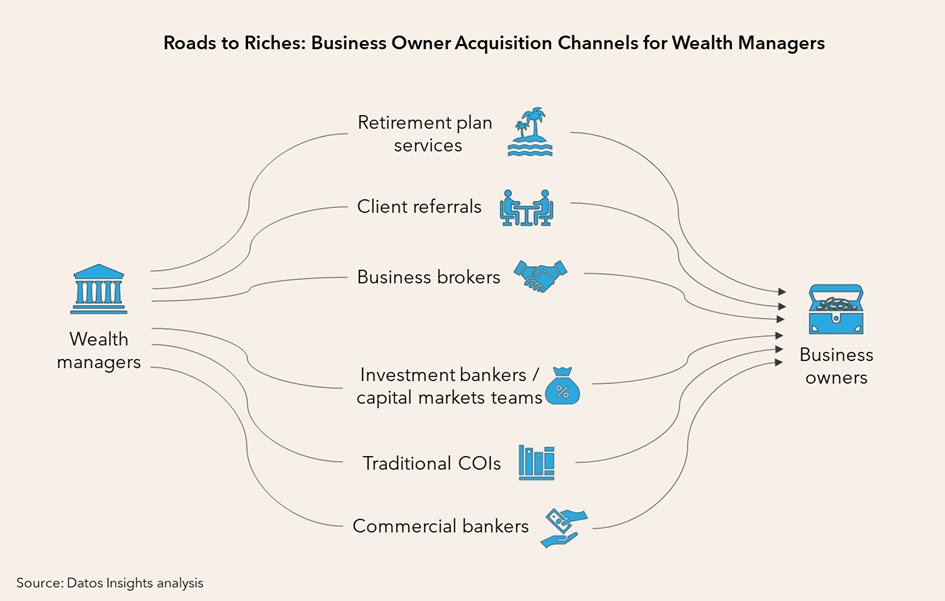Bank wealth managers sit on gold they can’t seem to mine. Despite being uniquely positioned to capture one of the most lucrative client segments in financial services, most are failing to capitalize on the enormous opportunity that business owners represent.
The $22 Trillion Opportunity Banks Are Letting Slip Away
Business owners control 30% of all financial wealth in the United States—approximately $22 trillion in assets. Nearly one-fourth of all closely-held business owners qualify as high-net-worth or ultra-high-net-worth clients, making them among the most attractive prospects for wealth management services.
In the ultra-high-net-worth segment, business owners represent 38% of all households, while in the high-net-worth segment, they comprise 24%. These clients don’t just represent volume—they represent value. Business owners account for a disproportionate share of total financial assets within each wealth segment, indicating they hold more wealth on average than other client types.

Banks’ Natural Advantage Goes Unrealized
Bank wealth managers should dominate this market. Nearly every business requires banking services, giving commercial banks direct relationships with millions of potential wealth management clients. Two-thirds of business owners—even those with substantial enterprises generating $5 million or more in annual revenue—maintain personal accounts at their business’s primary banking institution.
Yet bank-affiliated wealth managers control just over 10% of the total U.S. wealth market, leaving the vast majority of this opportunity on the table.
The Disconnect That’s Costing Banks Billions
The gap between opportunity and execution reveals a troubling reality: just 22% of business owners consolidate their personal investments with their business bank. When business owners maintain both business and personal banking relationships with the same institution, 90% keep their primary checking account there, but only 36% use that bank for managed investments.
This disconnect stems from multiple factors. Business owners report high satisfaction with their current wealth managers (71%), don’t see benefits to consolidating (31%), maintain strong relationships with existing advisors (28%), perceive their business bank’s investment fees as uncompetitive (22%), or question their bank’s investment capabilities (20%).
More concerning is what happens behind the scenes. Banks’ complex organizational structures create barriers between wealth managers and commercial bankers. Commercial bankers often resist making referrals, fearing that poor wealth-management service could jeopardize their commercial relationships. Without strong executive sponsorship compelling collaboration across business lines, these internal obstacles prove insurmountable.
The Solution: Strategic Partnerships That Actually Work
The most successful bank wealth managers have cracked the code through formal, incentivized partnerships between wealth advisors and commercial bankers. These partnerships share three critical characteristics:
Formal Structure: They create direct linkages between specific wealth advisors and commercial banking teams, not loose affiliations that rely on chance encounters.
Aligned Incentives: Both wealth advisors and commercial bankers receive goals and financial incentives for successful referrals and conversions.
Executive Support: Senior leadership actively champions these partnerships, recognizing that fee income from wealth management represents a crucial revenue stream that requires cross-divisional cooperation.
Data-Driven Prospecting Changes the Game
Forward-thinking banks leverage advanced analytics to identify which commercial banking clients represent the best wealth management prospects. Rather than asking commercial bankers to blindly suggest potential clients, wealth managers use algorithms to analyze customer data and present specific, targeted opportunities.
This approach transforms the dynamic. Commercial bankers receive concrete prospects to evaluate rather than vague requests for referrals. Wealth advisors gain regular touchpoints with their commercial banking partners, building stronger relationships while demonstrating their analytical sophistication.
One bank increased business-owner conversions from 7% to 12% of new business after implementing data-driven prospecting. Another doubled the percentage of annual new business coming from business owners through targeted analytics.
The Competitive Threat from RIAs
While bank wealth managers struggle with internal coordination, their competitors aren’t standing still. Independent registered investment advisors (RIAs) and broker-dealers actively court business owners through specialized retirement plan services, referral networks with business brokers, and relationships with traditional centers of influence like attorneys and accountants.
These competitors may lack a bank’s natural advantages, but they often move faster and focus more intensively on business-owner needs. They don’t face the organizational complexity that hampers bank wealth managers, allowing them to build stronger, more responsive relationships with this lucrative client segment.
Business-Owner Client Acquisition Can’t Wait
The business-owner opportunity won’t wait forever. As these wealthy clients age and consider succession planning, wealth managers who establish strong relationships today will benefit for decades. Banks that fail to capture this opportunity risk watching billions in potential assets flow to more agile competitors.
Success requires more than recognizing the opportunity—it demands systematic execution. Banks must create formal partnership structures, align incentives across business lines, invest in data analytics capabilities, and secure executive sponsorship for cross-divisional collaboration.
The $22 trillion question facing bank wealth managers is simple: Will they finally capitalize on their unique positioning, or will they continue letting this massive opportunity slip through their fingers?
Download the complete report, Eyes on the Prize: Converting Business Owners to Wealth Management Clients, to discover proven strategies, detailed case studies, and actionable recommendations for capturing this lucrative market.

